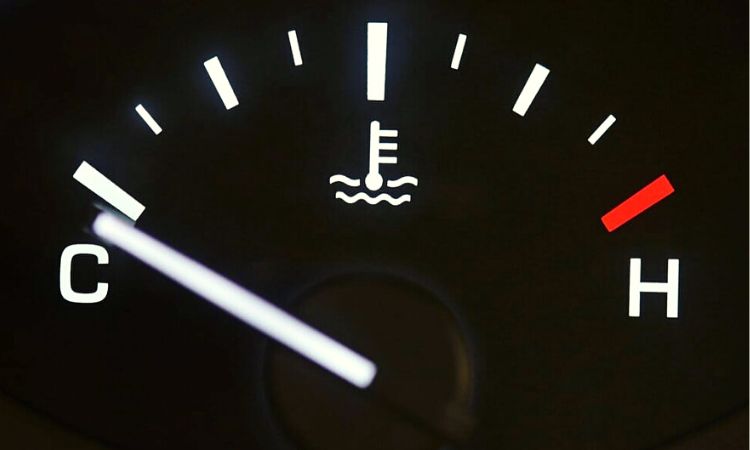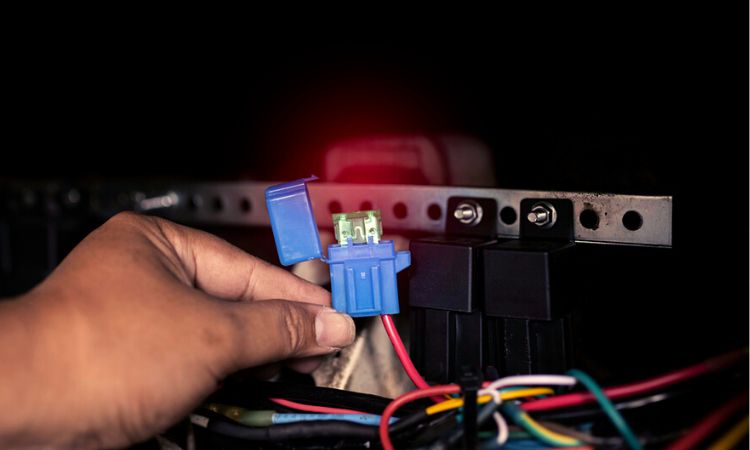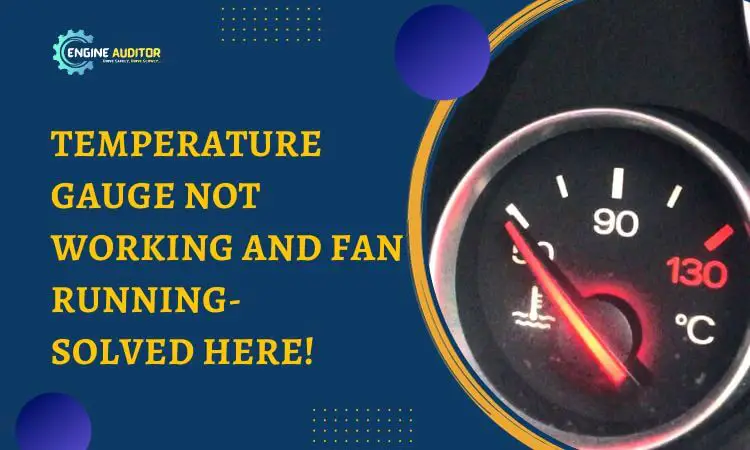Hey there! This post contains affiliate links to products. We may receive a commission for purchases made through these links. But it never influences our product selection process.
The temperature gauge tells you about the engine coolant temperature. A faulty temperature gauge can slow down your vehicle’s performance and fuel economy. How do you troubleshoot a temperature gauge not working and fan running?
A blown fuse and low coolant are common causes that can be diagnosed and fixed easily. Replace the fuse or refill the coolant. However, faulty temperature sensors, coolant fan relays, and broken thermostats can be the reasons for that issue. It will also be helpful if you check for these issues, too.
Let’s stay together and learn how to sort out the cause and fix the issue.
Possible Causes for Temperature Gauge Not Working
Temperature gauge faults may appear in your vehicle due to the reasons below.
- Faulty Temperature Sensor
- Blown Fuse
- Cooling Fan Relay Failure
- Broken Thermostat
- Low Coolant Level
Temperature Gauge Not Working and Fan Running

Problem 1: Faulty Temperature Sensor
Temperature sensors send the temperature readings to the gauge to show the correct temperature on the dashboard.
However, if the sensors have a fault, they may fail to monitor temperature properly and send wrong readings. It may show a lower temperature than the actual, damaging your engine if it remains longer.
Solution:
- Turn your vehicle’s engine off to ensure safety.
- Then, look for the temperature sensors, usually mounted near the radiator.
- Once found, disconnect it from the power source.
- Then, remove the sensor using a wrench.
- Check it to ensure the fault; if it is bad, replace it with a compatible sensor.
- Secure the sensor, ensure it is tight enough, and reconnect it to the power source.
- Start the engine and verify that the problem has been fixed.
Are you looking for comfortable seats? Read this blog: What is Syntex seating material?
Problem 2: Blown Fuse

The fuse supplies power to the temperature gauge and controls fan movement. But if the fuse is blown, it will not supply power to the gauge; it may give wrong or no reading, and the fan will run continuously.
Solution:
- Open your car’s dashboard and look for the fuse box, usually located in the engine compartment.
- Read the diagram on the fuse box to locate the fuse for the temperature gauge.
- Once located, check it thoroughly; if it is damaged, remove it using pliers.
- Take a new fuse of the same amperage and mount it properly.
- Once done, close the fuse box and dashboard, start the engine, and ensure the issue has been resolved.
Problem 3: Cooling Fan Relay Failure
The cooling fan relay controls the fan’s operations; if it fails, the fan may run continuously. Due to the inconsistent operation of the fan, the temperature gauge may also become inconsistent. You may get the wrong readings on the dashboard.
Solution:
- First, find the cooling fan relay, usually mounted in the fuse box.
- Once you find the fan relay, remove and inspect it thoroughly to ensure it is okay. If there is physical damage, replace it with a compatible cooling fan relay.
- After relay replacement, test and ensure the problem is removed.
Problem 4: Broken Thermostat
A thermostat maintains the temperature of the engine for safe functioning. If it is broken, it may also affect the temperature gauge’s performance. The temperature gauge may need to provide correct temperature readings.
Solution:

- Turn your car’s engine off to ensure a safe job.
- Then, open your car’s hood and locate the thermostat. In most vehicles, it is usually mounted near the engine’s top.
- Once found, remove its housing and then remove it. Check the thermostat for physical damage. If it is broken, go for a replacement.
- Replace it with a new one. I recommend Mishimoto MMTS-JED-06L Racing Thermostat for your car for excellent performance.
- Put the thermostat housing close to the hood and start the engine to check for issues. Make sure the temperature gauge is functioning fine.
Problem 5: Low Coolant Level
One of the typical causes of temperature gauge failure is low coolant levels. A low coolant level may cause engine overheating, which may cause the temperature gauge to send wrong readings on the dashboard.
Solution:
- Park your car on a level surface and turn the engine off. Let it sit for a few minutes to cool down the engine.
- Open the car’s hood and access the coolant tank.
- Dip the stick and check the coolant level to ensure it is at the recommended level. If it is down, refill the good quality coolant. I recommend PEAK Concentrate Antifreeze and Coolant for good performance.
- Once refilled, close the tank and hood and let the vehicle sit for at least 10 minutes. After 10 minutes, start the engine and ensure the problem is gone.
Temperature Gauge Not Moving
If you are experiencing a temperature gauge moving problem, it can be due to several reasons, such as those given below.
- Low coolant
- Faulty sensor
- Stuck or broken thermostat
- Broken temperature gauge
Solution
- First, check the coolant level and ensure it is at the recommended level. Refill if needed.
- Next, check for the sensor in the fuse box and ensure it is fine; replace it if there is a fault.
- Also, check the thermostat. It may be broken or stuck; if stuck, remove the issue by repairing it. But you will need a replacement if it is broken.
- Finally, check the temperature gauge and ensure it is not broken. If broken, replace the gauge.
Car Temperature Gauge Stays on Cold and AC Not Working
You may experience that issue for multiple reasons, but the two most common causes of the car temperature gauge staying on cold but the AC not working are given below.
- Low refrigerant level
- Faulty thermostat
Solution
- First, check the AC refrigerant and ensure it is at the correct level. If the refrigerant level is low, refill it.
- Next, check the thermostat and ensure it is okay; repair it if its parts are damaged. But if it is broken, you will need a replacement.
Temperature Gauge Stuck on Hot
Your vehicle’s temperature gauge may get stuck on hot due to the reasons below.
- Faulty temperature sensors
- Engine overheating
Solution
- First, check for the temperature sensors and ensure they are working fine; replace the faulty sensors.
- Also, check for engine overheating; it may be due to low coolant levels. If the coolant level is low, let your engine cool for 30 minutes and then refill the coolant.
Seeking Professional Help For Complex Issues
Fixing temperature gauge failure is a time-consuming process. You need to follow the above instructions carefully to avoid damage. If you have tried all the above solutions, but the issue persists, call for professional assistance to fix the problem.
Frequently Asked Questions (FAQs):
How to tell if your car temperature gauge is broken?
01. Erroneous readings
02. Check engine light.
03. Engine start issues
04. Engine overheating
05. Black smoke when accelerating
What sensor controls the temperature gauge?
How much is it to fix the temperature gauge not working and fan running?
However, severe issues such as engine problems may increase this cost by hundreds or even thousands of dollars.
Can I drive with a faulty temperature gauge?
Conclusion
A faulty temperature gauge with a running fan can be an alarming issue if not addressed properly. It happens for several problems that need proper diagnosis and then fix.
But don’t worry; mostly, you can fix it independently, following the above guidelines. However, if the issue persists, consult with an expert or professional for a proper solution.

